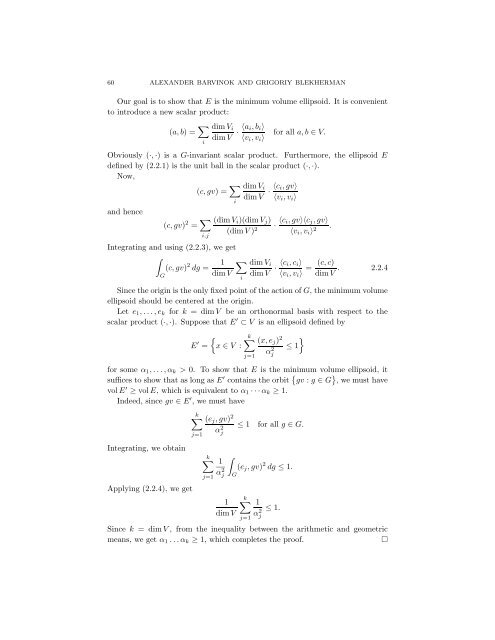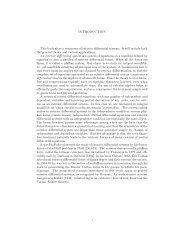You also want an ePaper? Increase the reach of your titles
YUMPU automatically turns print PDFs into web optimized ePapers that Google loves.
60 ALEXANDER BARVINOK AND GRIGORIY BLEKHERMAN<br />
Our goal is to show that E is the minimum volume ellipsoid. It is convenient<br />
to introduce a new scalar product:<br />
(a,b) = �<br />
i<br />
dimVi<br />
dimV<br />
· 〈ai,bi〉<br />
〈vi,vi〉<br />
for all a,b ∈ V.<br />
Obviously (·, ·) is a G-invariant scalar product. Furthermore, the ellipsoid E<br />
defined by (2.2.1) is the unit ball in the scalar product (·, ·).<br />
Now,<br />
(c,gv) = �<br />
and hence<br />
G<br />
(c,gv) 2 = �<br />
i,j<br />
i<br />
dimVi<br />
dimV<br />
(dimVi)(dim Vj)<br />
(dimV ) 2<br />
Integrating and using (2.2.3), we get<br />
�<br />
(c,gv) 2 dg = 1 � dimVi<br />
dimV dimV<br />
i<br />
· 〈ci,gv〉<br />
〈vi,vi〉<br />
· 〈ci,gv〉〈cj,gv〉<br />
〈vi,vi〉 2 .<br />
〈ci,ci〉 (c,c)<br />
· = . 2.2.4<br />
〈vi,vi〉 dimV<br />
Since the origin is the only fixed point <strong>of</strong> the action <strong>of</strong> G, the minimum volume<br />
ellipsoid should be centered at the origin.<br />
Let e1,...,ek for k = dim V be an orthonormal basis with respect to the<br />
scalar product (·, ·). Suppose that E ′ ⊂ V is an ellipsoid defined by<br />
E ′ =<br />
�<br />
x ∈ V :<br />
k� (x,ej) 2<br />
j=1<br />
α 2 j<br />
�<br />
≤ 1<br />
for some α1,...,αk > 0. To show that E is the minimum volume ellipsoid, it<br />
suffices to show that as long as E ′ contains the orbit � gv : g ∈ G � , we must have<br />
volE ′ ≥ volE, which is equivalent to α1 · · ·αk ≥ 1.<br />
Indeed, since gv ∈ E ′ , we must have<br />
Integrating, we obtain<br />
Applying (2.2.4), we get<br />
k� (ej,gv) 2<br />
≤ 1 for all g ∈ G.<br />
j=1<br />
k�<br />
α 2 j<br />
1<br />
α<br />
j=1<br />
2 j<br />
�<br />
G<br />
1<br />
dimV<br />
(ej,gv) 2 dg ≤ 1.<br />
k�<br />
1<br />
α<br />
j=1<br />
2 j<br />
≤ 1.<br />
Since k = dimV , from the inequality between the arithmetic and geometric<br />
means, we get α1 ...αk ≥ 1, which completes the pro<strong>of</strong>. ˜




